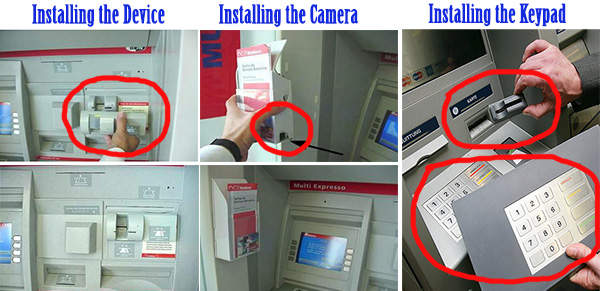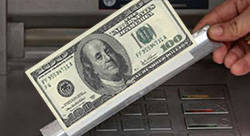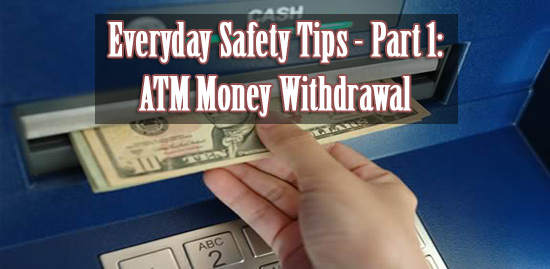You don’t have to be a prepper to understand the importance of a few everyday safety-tips.
Today only small crooks rob people on the streets. The real thieves are too cunning and elusive for your guns to “catch”. If you are thinking that an everyday carry is enough to protect yourself – against people who are thinking how to rob you every day and night – then you are dead wrong!
In the situations bellow (all 100% real) you’ll find out how to protect against the most popular scams and methods of stealing money from your account at the ITM or when you pay with the card.
1. The Infra-Red Method
A new way for thieves to steal your ATM PIN code is to use an infra-red device. Mark Rober explains in the video bellow how this works. When you press the buttons on a keypad to enter your debit card PIN, for example, your fingers leave behind that thermal signature for the thieves to pick up with the camera.
The problem with this method is that the thieves still have to get your card’s details. But no problem, this can be done in a few simple ways that you are about to discover bellow.
Besides that, an accomplice employee who has access to security cameras can see your card’s details on the footage previously taken.
Safety Tip: Rest your fingers on other buttons too. Make sure no camera can see your cant number (Put one finger on the numbers while you insert the card).
2. Phishing Attacks
This is the most common method in the United States. Phishing attack losses are estimated at around $3.00 billion every year… which is quite huge. It’s like stealing $9 from every American.
How does it work?
The thieves use a device that captures your card’s information and they replicate it afterwards. They also use a hidden camera to film your pin number (or a fake pad). After they replicate the card they can use it whenever they want … just like you.
These devices are often mounted alongside a machine and are difficult to notice unless you’re looking for them:

Safety Tips:
- Get in the habit of using the same ATM machine. Become familiar with it and be able to recognize small changes to the machine;
- Cover with your hand the keypad; in case there are hidden cameras, they won’t be able to see your PIN;
3. Wireless Card Reader Method
This new kind of thievery is on the rise. Criminals can now steal your credit card data by walking by you with an electronic scanner, even with their mobile phones.
The new threat exists because of the radio-frequency identification chips (RFID) or Near Field Communication (NFC) chips that are embedded in almost all credit and debit cards. A modern thief can use this “swipe to pay” technology to capture your info by scanning your wallet or purse with an electronic scanner.
Safety Tips:
- Don’t let anyone close to your wallet;
- Keep two RFID cards in your wallet – the scanner can’t read them because they confuse the information;
- Put a piece of aluminum foil in your wallet – the scanner will try to read the aluminum foil;
4. Cash Trapping
 In this scam, a blocking device is inserted into the card slot of the ATM machine or into the cash dispenser. You place your card into the machine and enter your PIN. You withdraw the money but they don’t come out because they are stuck in the machine. Or you withdraw the money but can’t withdraw the card.
In this scam, a blocking device is inserted into the card slot of the ATM machine or into the cash dispenser. You place your card into the machine and enter your PIN. You withdraw the money but they don’t come out because they are stuck in the machine. Or you withdraw the money but can’t withdraw the card.
All the while, someone is watching you.
A very common reaction is to go to the bank and report the problem. Or if the money are stuck … maybe you’ll go to another ATM and see if it works.
When you leave the ATM the thieves jump into action. They remove the blocking device, along with your trapped ATM card and withdraw money from your account. Or if they use a device to trap money they simply remove it and take the money you wanted to withdraw.
Safety Tip: If your money or card does not come out of the ATM, call the cops. Don’t leave the ATM !
5. The Brick Method
One of the most vulnerable moments is when we sit in front of an ATM machine. After we inserted the card and the PIN code… anyone can withdraw our money. One of the methods thieves use, started a few years ago in China. This method is pretty simple and brutal… after the person inserts the card and the PIN, the thief hits him/her in the head with a brick and steals the money from your account.
Safety Tip: Constantly look over your shoulder when you withdraw money; try to avoid withdrawing money at night;
Please share with us other methods used by crooks so we can make this piece of advice as comprehensive as possible.
Other Safety Tips:
- Put your cash, card and receipt away immediately. Count your money later, and always keep your receipt.
- If you see anyone or anything suspicious, cancel your transaction and leave immediately.
- Do not leave your car unlocked or engine running when you get out to use an
- While many ATMs are available 24 hours a day, some may be open only during local business hours. To be on the safe side, plan your withdrawals ahead of time
Here are some awesome tips to secure your home against looter and criminals.
You may also like:
 How To Make A Long Lasting Pork Rillette (With Pictures)
How To Make A Long Lasting Pork Rillette (With Pictures)
10 Things Cowboys Carried With Them in the Wild West to Survive (Video)
Classified FEMA Report Confirms Preppers’ Worst Fears






















Safety should be a priority in daily life, whether at home, work, or in public spaces. Simple precautions can prevent accidents and ensure well-being. Always be aware of your surroundings, especially in potentially hazardous areas like atex zones where explosive atmospheres may be present. Using proper equipment and following safety regulations in such environments is crucial. At home, secure electrical outlets, avoid cluttered walkways, and store hazardous materials properly. When outdoors, follow traffic signals and stay alert. By taking small steps, you can significantly enhance everyday safety.